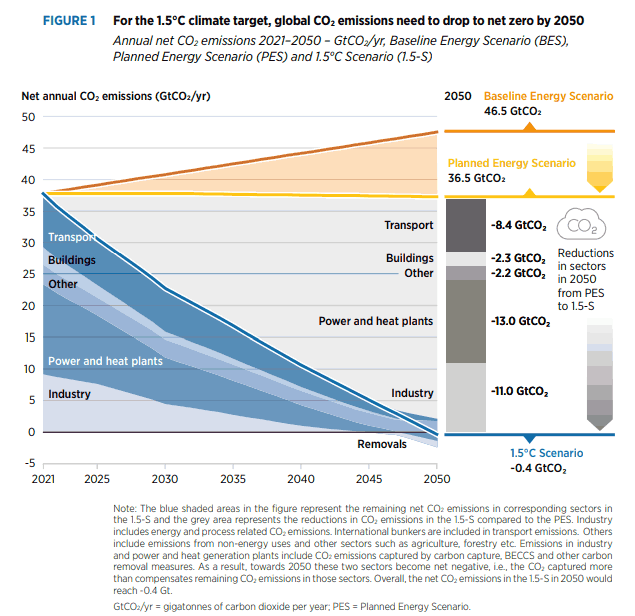If the world wants to reduce carbon emission at a level needed to meet UN climate change targets, it’s going to cost a lot of money.
A really, really lot of money.
Supply Chain Digest Says...
|
 |
| China is the top CO2 emitter globally, and which continues to build significant coal-powered energy capacity. |
 |
What do you say? |
| Click here to send us your comments |
|
 |
| Click here to see reader feedback |
|
Last month, an organization called the International Renewable Energy Agency (IRENA), an intergovernmental organization based in Abu Dhabi, released a report saying the world needs to spend $131 trillion on the energy transition by 2050 to make it through “a window that’s closing fast” in terms of hitting targets on global warming coming out of the UN Paris Climate accord of 2015.
Under then President Obama, the US signed on to that accord, only have new President Trump pull out of the agreement soon after he took office in 2017. Then, President Biden re-committed to the accord quickly after he took office in January.
The Paris agreement hopes to limit the temperature rise to 1.5 degrees C.
IRENA calls for global energy transition investment to rise by 30% over currently planned levels to an average of $4.4 trillion annually to 2050.
That would help fund a transformed energy system with more than ten times the renewable capacity installed today – hitting 27,700 gigawatts by 2050 – accounting for 90% of all electricity produced, with power accounting for more than 50% of final energy consumption, up from 21% currently.
IRENA says so-called “green hydrogen” should play a huge role in decarbonizing industry and transport, with production of what it calls ‘the key energy transition fuel”providing 30% of all power by 2050. On the flip side, there would be a 75% fall in fossil fuel consumption, according to IRENA’s plan.
The chart below from the report shows just how great the effort will be to get to zero emissions by 2050 across various sectors.

(See More Below)
|
CATEGORY SPONSOR: SOFTEON |
|
|
| |
|
|
Among other findings, the IRENA report says:
• A combination of technologies is needed to keep us on a 1.5 degrees C climate pathway. These include increasingly efficient energy production to ensure economic growth; decarbonized power systems that are dominated by renewables; increased use of electricity in buildings, industry and transport to support de-carbonization; expanded production and use of green hydrogen, synthetic fuels and feedstocks; and targeted use of sustainably sourced biomass.
• In anticipation of the coming energy transition, financial markets and investors are already directing capital away from fossil fuels and towards other energy technologies including renewables.
• Energy transition investment will have to increase by 30% over planned investment to a total of $131 trillion between now and 2050, corresponding to $4.4 trillion on average every year.
• National social and economic policies will play fundamental roles in delivering the energy transition at the speed required to restrict global warming to 1.5 degrees C.
• Much of the ability to reduce global carbon emissions depends on China and India, which are heavily dependent on coal to generate power. China is the top CO2 emitter globally, and which continues to build significant coal-powered energy capacity.
David Victor of the University of California San Diego, who focuses on climate policies, told the Wall Street Journal that getting to zero CO2 requires the difficult task of “eliminating essentially all fossil fuels.”
“What do you do about cement? What do you do about steel production? What do you do about agriculture? What do you do about aviation and shipping?” he asks. “There’s a tendency when you study radical technological change to overestimate what’s possible in the near term.”
For example, China will need to invest $21 trillion over the next 30 years to transform transportation, industry and construction while building nuclear, wind and solar production capacity to reach the goal of zero net emissions by 2060, according to a report presented by China’s leading climate experts in October at Tsinghua University. That amounts to more than 2.5% of its annual gross domestic product.
Will China and India really be willing to make such investments?
The experience of France also illustrates the challenge. French commuters led the yellow-vest protest movement that erupted in late 2018 in opposition to President Emmanuel Macron’s plans to raise fuel taxes, ultimately forcing him to back down.
“The experience made Mr. Macron, a business-friendly centrist, an opponent of dramatic changes to the French economy. The country is unlikely to meet climate targets without new policies,” the Wall Street Journal recently reported .
The full IRENA report is available here: World Energy Transitions Outlook
What do you think of the investmented needed to reduce CO2 emissions to zero? Let us know your thoughts at the Feedback section below.
|